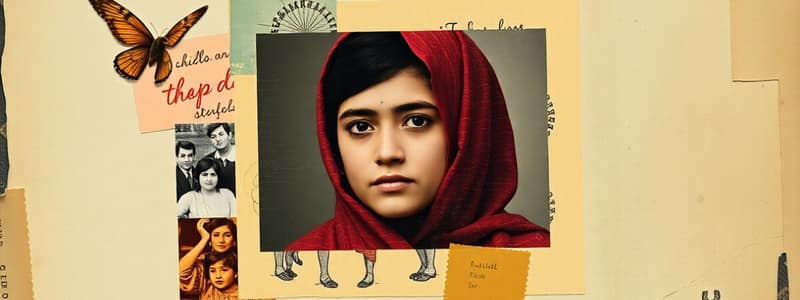Podcast
Questions and Answers
In the context of Malala's narrative, the act of taking Safina's earrings and necklace most directly violates which tenet of Pashtunwali, considering the nuanced interpretation of familial honor and social responsibility?
In the context of Malala's narrative, the act of taking Safina's earrings and necklace most directly violates which tenet of Pashtunwali, considering the nuanced interpretation of familial honor and social responsibility?
- Badal (revenge), because it initiates a cycle of retribution, undermining the Pashtun value of resolving disputes through peaceful means and forgiveness. (correct)
- Melmastia (hospitality), as it disrupts the harmony within Safina's household and Malala's family's capacity to offer refuge.
- Nang (honor), given that Malala's actions could be perceived as a direct challenge to Safina's family's reputation and societal standing.
- Tureh (courage), as it reflects a lack of moral fortitude to resist impulsive reactions, thereby setting a poor example within their community.
Considering Malala's father's reference to Mahatma Gandhi and Mohammad Ali Jinnah, what profound underlying message was he attempting to convey regarding leadership and moral fallibility in the context of Pashtun societal expectations?
Considering Malala's father's reference to Mahatma Gandhi and Mohammad Ali Jinnah, what profound underlying message was he attempting to convey regarding leadership and moral fallibility in the context of Pashtun societal expectations?
- That leaders are exempt from the Pashtunwali code due to their elevated societal roles.
- That even exemplary leaders are susceptible to moral imperfections, but their capacity to acknowledge flaws and learn from errors is essential for authentic leadership. (correct)
- That leadership necessitates absolute adherence to Pashtunwali without any deviation, as any mistake undermines their authority.
- That all leaders make mistakes, but their ability to adhere to Islamic principles ultimately defines their legacy.
In what manner does Malala's admission of suspecting Safina of theft but withholding this information from others reflect the intricate interplay between personal ethics, social harmony, and the constraints imposed by cultural norms within her community?
In what manner does Malala's admission of suspecting Safina of theft but withholding this information from others reflect the intricate interplay between personal ethics, social harmony, and the constraints imposed by cultural norms within her community?
- It demonstrates a prioritization of personal gain over communal harmony.
- It showcases adherence to Pashtunwali by avoiding public accusations, thereby protecting family honor.
- It underscores the tension between personal integrity and the preservation of social harmony, highlighting the complexities of navigating cultural expectations while grappling with individual moral concerns. (correct)
- It underscores a strategic approach to conflict resolution, carefully weighing personal grievances.
How does the juxtaposition of Malala's childhood games amidst ancient ruins symbolize the intricate relationship between historical legacy, cultural identity, and the resilience of youth in the Swat Valley?
How does the juxtaposition of Malala's childhood games amidst ancient ruins symbolize the intricate relationship between historical legacy, cultural identity, and the resilience of youth in the Swat Valley?
Considering the dual act of stealing and subsequent apology, how might a critical theorist interpret Malala's actions within the framework of power dynamics and social conditioning prevalent in her community?
Considering the dual act of stealing and subsequent apology, how might a critical theorist interpret Malala's actions within the framework of power dynamics and social conditioning prevalent in her community?
How does the inclusion of specific details like 'hot tea and cardamom' by their mother contribute to the narrative's overall impact, considering the broader themes of cultural identity, familial bonds, and resilience in the face of adversity?
How does the inclusion of specific details like 'hot tea and cardamom' by their mother contribute to the narrative's overall impact, considering the broader themes of cultural identity, familial bonds, and resilience in the face of adversity?
Synthesizing the narrative elements—the theft, the apology, the father's advice, and the backdrop of ancient ruins—how might a postcolonial scholar interpret Malala's childhood experience as a microcosm of the broader socio-political dynamics at play in the Swat Valley?
Synthesizing the narrative elements—the theft, the apology, the father's advice, and the backdrop of ancient ruins—how might a postcolonial scholar interpret Malala's childhood experience as a microcosm of the broader socio-political dynamics at play in the Swat Valley?
Flashcards
Pink Plastic Cell Phone
Pink Plastic Cell Phone
A gift from Malala's father, symbolizing her childhood.
Safina
Safina
Malala's friend who claimed to own a similar phone.
Pashtunwali Code
Pashtunwali Code
A traditional code of ethics for the Pashtun people, emphasizing honor and respect.
Badal
Badal
Signup and view all the flashcards
Mahatma Gandhi
Mahatma Gandhi
Signup and view all the flashcards
Childhood Mistakes
Childhood Mistakes
Signup and view all the flashcards
Grassy Lot
Grassy Lot
Signup and view all the flashcards
Study Notes
Malala's Childhood in Pakistan
- Malala lived in a house where she watched TV shows like Shaka Laka Boom Boom
- She played with her friend Safina, making toys from fabric and matchsticks
- Malala's favourite possession was a pink plastic cell phone
- The phone was stolen and Malala felt guilty and upset
- Malala mistakenly took Safina's trinkets and earrings, which upset her mother
- Her father didn't scold her but consoled her instead
- He told stories about figures like Mahatma Gandhi and Mohammad Ali Jinnah
- The Pashtunwali code, a tradition of revenge, was discussed
- Malala made the decision not to retaliate against Safina
- She apologised but Safina did not
- They were quick to forgive each other
- They lived in a part of town with a grassy field and ruined structures
Neighbourhood and Pashtunwali Code
- They played games like parpartuni (hide-and-seek) in summer and made snowmen in winter
- The family lived in a part of town far from the city centre
- The family lived in an area filled with statues of lions, columns of an old stupa
- Hundreds of large stones resembling umbrellas were in the field
- Pashtunwali code is tied to revenge (one insult needing another insult back)
- This code is a cultural tradition in her community
Studying That Suits You
Use AI to generate personalized quizzes and flashcards to suit your learning preferences.




